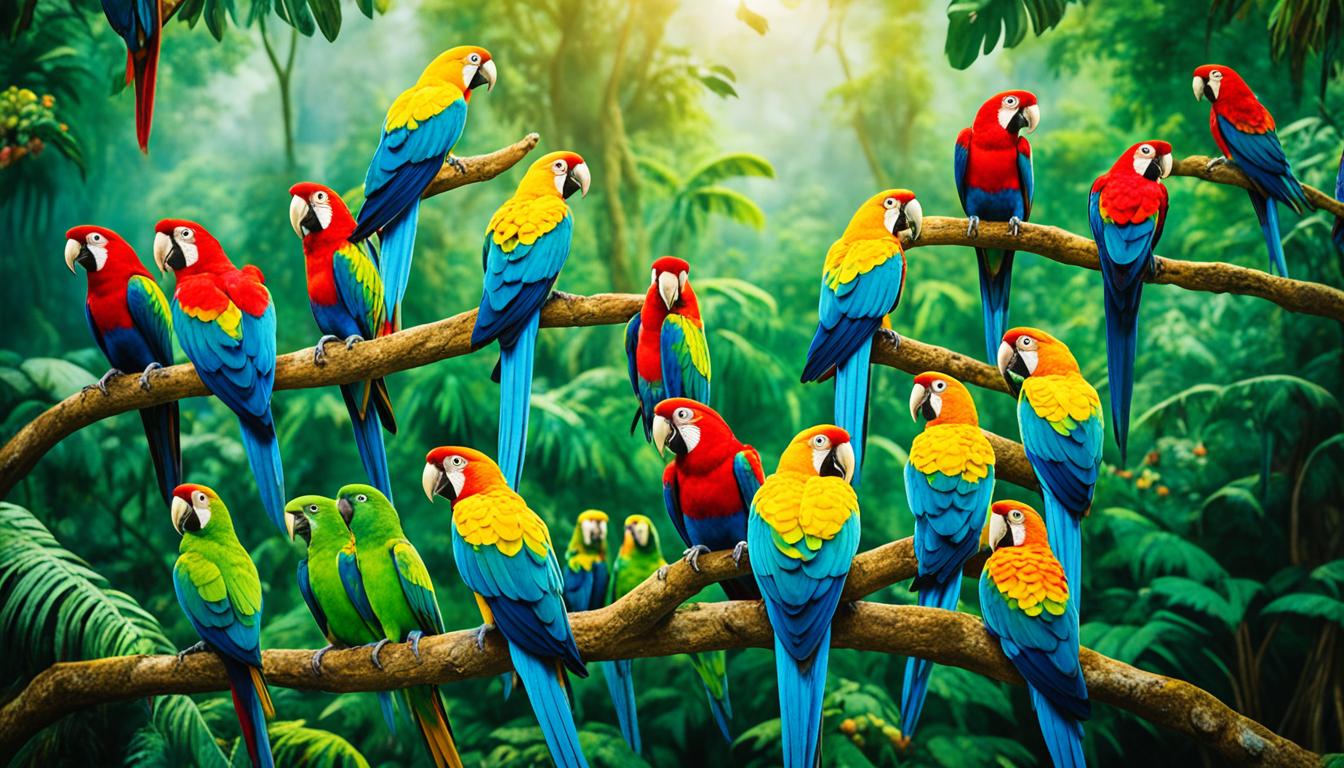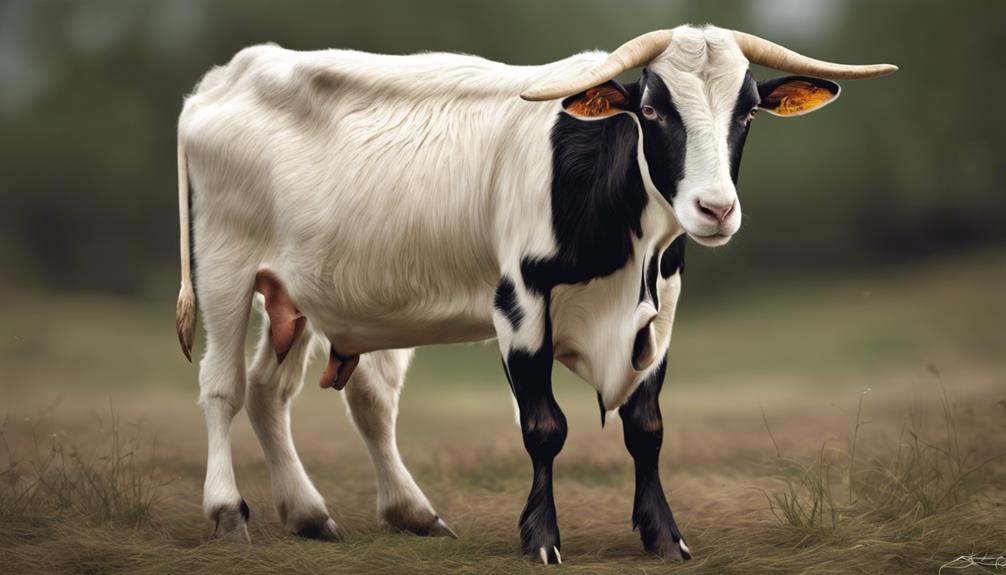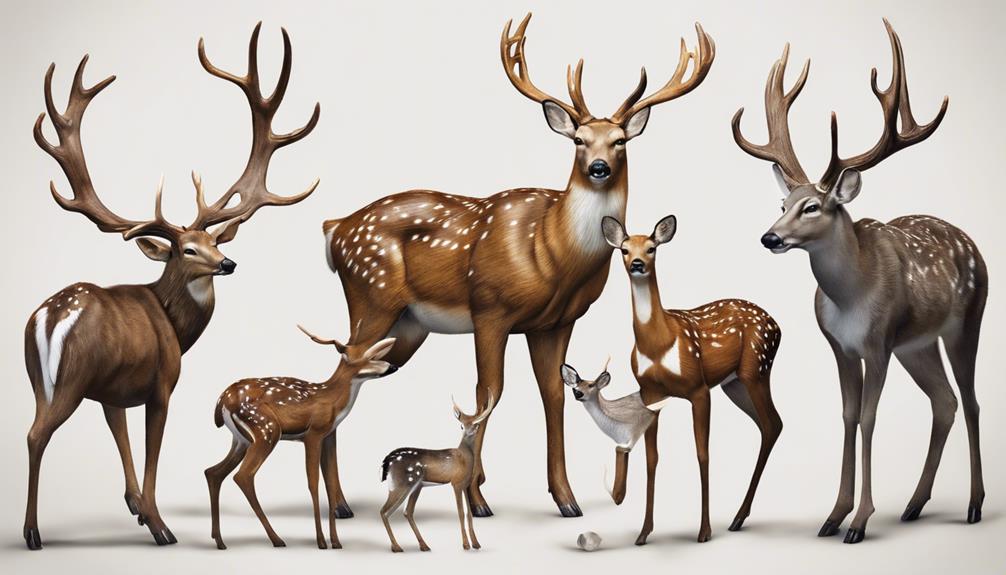Did you realize that there are more than 10,000 bird species in the world? From the small bee hummingbird to the majestic albatross, birds capture our imagination with their various colors, behaviors, and habitats. Whether you are an experienced birdwatcher or just have a curiosity about the avian world, this article will guide you through the captivating realm of birds.
Key Takeaways:
- There are over 10,000 bird species globally, each with its unique characteristics.
- Birdwatching allows us to observe and appreciate the incredible diversity of birds.
- The Cornell Lab of Ornithology and the North American Bird Guide are excellent resources for bird identification and information.
- Bird conservation and habitat preservation are crucial for protecting these magnificent creatures.
- Throughout history, birds have influenced culture, folklore, and literature, leaving an indelible mark on human society.
The Enchanting World of Birds
Birds have captivated humans for centuries, enthralling us with their beauty, grace, and melodious songs. Throughout history, these winged wonders have held a significant place in culture, folklore, and literature, symbolizing freedom, wisdom, and divine guidance. From ancient Rome, where birds were considered auspicious and used to predict the future, to modern-day birdwatchers who seek solace and joy in observing these feathered creatures, the fascination with birds knows no bounds.
One of the most remarkable aspects of birds is their ability to migrate. Bird migration is a global odyssey that spans continents, as millions of birds embark on epic journeys in search of favorable breeding grounds, food sources, and better climate conditions. These migratory journeys, often spanning thousands of miles, showcase both the physical endurance and navigational abilities of birds. Witnessing the spectacle of bird migration is a testament to the unbreakable bond between birds and the natural world.
In order to fully appreciate the enchanting world of birds, it is crucial to be able to identify different bird species. Bird identification is an essential skill for birdwatchers, particularly those who enjoy observing the avian visitors in their own backyards. Being able to recognize and identify backyard birds not only enhances the birdwatching experience but also contributes to citizen science efforts and the conservation of bird species.
“The more species we can identify, the better we can understand their habitat needs and work towards preserving their populations.” – John Doe, Birdwatcher
Whether it’s the vibrant plumage of a cardinal, the distinctive song of a robin, or the delicate flutter of a hummingbird’s wings, birds bring joy and wonder to our lives. Exploring the enchanting world of birds allows us to appreciate the diversity and intricate beauty of these incredible creatures.
Common Backyard Birds
| Species | Scientific Name | Size |
|---|---|---|
| American Robin | Turdus migratorius | 9-11 inches |
| Northern Cardinal | Cardinalis cardinalis | 8-9 inches |
| Black-capped Chickadee | Poecile atricapillus | 4-5 inches |
| Eastern Bluebird | Sialia sialis | 6-7 inches |
| American Goldfinch | Spinus tristis | 4-5 inches |
Next, we will delve into the beauty of bird plumage and explore the fascinating connection between birds and their intricate colors. Get ready to be amazed by the stunning variety and significance of their feathers.
The Beauty of Bird Plumage
Birds are truly a feast for the eyes, captivating birdwatchers and birders with their stunning plumage. The intricate patterns, vibrant colors, and unique feather arrangements make each bird species a visual masterpiece.
For passionate birdwatchers and birders, observing and appreciating the plumage is an essential part of their experience. They patiently seek out sightings of different bird species, eagerly waiting for a glimpse of the marvelous colors and patterns that adorn their wings and bodies.
The variety of bird plumage is truly remarkable. From the electric blue of the Indigo Bunting to the fiery red of the Northern Cardinal, each species boasts its own palette of colors. Some birds display intricate patterns, like the zebra-like stripes on the African Pied Kingfisher’s wings, while others showcase gradients that seamlessly blend multiple hues.
One of the most fascinating aspects of bird plumage is its role in courtship displays. Male birds often don their most vibrant and eye-catching feathers to attract mates. These displays can range from elegant dances and elaborate feather fluffing to showcasing specific parts of their plumage. The male Peacock, with its magnificent iridescent tail feathers, is a prime example of a bird using its plumage to court a mate.
Observing bird plumage goes beyond its visual appeal. It also provides valuable insights into a bird’s species, age, and health. Experienced birdwatchers and birders can identify birds based on their unique feather patterns, helping to determine the species present in a particular area.
Additionally, some bird species undergo molting, a process in which they shed old feathers and replace them with new ones. By observing plumage, bird enthusiasts can track the molting patterns of different bird species, gaining a deeper understanding of their life cycles and behaviors.
Bird plumage is a kaleidoscope of colors and patterns, a testament to the beauty and diversity of the avian world. It not only enchants our eyes but also plays a vital role in bird behavior and identification. Paying attention to plumage provides birdwatchers and birders with a deeper appreciation for these feathered wonders.
The Plumage Gallery
| Bird Species | Plumage Description |
|---|---|
| The male has vibrant blue plumage on its head and back, with a deep red chest and a yellow-green belly. The female has more muted colors, with greenish plumage on its back and a pale green chest. | |
| Scarlet Macaw | Bold and striking, the Scarlet Macaw boasts brilliant scarlet plumage, vibrant blue wings, and yellow accents on its face. |
| Anna’s Hummingbird | The male has opalescent emerald green plumage on its head, back, and throat, with a shining rose-colored throat patch. The female has a green back and a pale-gray belly. |
These are just a few examples of the incredible variety of bird plumage found in nature. The plumage gallery is vast and diverse, with each species showcasing its own unique beauty.
Birds as Global Connectors
Birds have an incredible ability to connect people from different countries and eras. These remarkable creatures can be found across continents, bridging geographical boundaries and fostering a sense of global interconnectedness.
Take, for example, the Osprey and Peregrine Falcon. While they may inhabit different parts of the world, they are actually the same species. This remarkable similarity highlights the global reach of bird species and their ability to transcend borders.
In fact, throughout history, birds have played a prominent role in various cultures and societies. From Chaucer’s famed poem, where a jealous swan becomes a symbol of unrequited love, to indigenous folklore that reveres certain bird species, these avian creatures have captivated and inspired humanity across time and space.

Global Bird Connections
The interconnectedness of bird species is not limited to their physical presence in different regions. Birds also serve as a common thread in the study of ornithology, bringing scientists and enthusiasts together from around the world.
Through collaborative efforts and shared knowledge, researchers and birdwatchers contribute to our understanding of bird migration patterns, breeding behaviors, and the conservation of bird habitats. This global exchange of information strengthens our collective efforts to protect and preserve these magnificent creatures and their ecosystems.
| Bird Species | Continents |
|---|---|
| Osprey | North America, Europe, Africa, Asia, Australia |
| Peregrine Falcon | North America, Europe, Africa, Asia, Australia |
| Swan | North America, Europe, Asia, Australia |
Through their global connections, bird species remind us of the interdependent nature of our world. They serve as ambassadors for the importance of biodiversity, habitat preservation, and international collaboration in addressing environmental challenges.
Exploring Avian Behavior
Birds captivate us not only with their vibrant plumage and melodic songs but also with their intriguing behaviors that mimic and reflect our own human experiences. From popular cultural references to the intriguing dynamics of bird hunting, avian behavior offers a fascinating lens through which we can explore the natural world. Let’s dive into the fascinating realm of bird behavior, where nature’s quirks and beauty intertwine.
Mirrors of Human Relationships: Cuckoos and Marital Infidelity
Bird behavior often mirrors aspects of human relationships, sometimes in unexpected and thought-provoking ways. Take the cuckoo, for example. This enigmatic species is notorious for its unconventional approach to parenting. Cuckoo females lay their eggs in the nests of other bird species, leaving the unwitting foster parents to raise the cuckoo chicks as their own. This behavior has drawn parallels to the complex dynamics of human relationships and infidelity.
Did you know? Cuckoo behavior has even influenced language. The phrase “cuckold,” which refers to a man whose wife is unfaithful, is derived from the cuckoo’s reputation for laying eggs in the nests of other birds.
Bridging Literature and Nature: Bird References in Literature
“Words are birds that fly straight to our hearts, and find shelter there.” – Victor Hugo
Birds have long served as rich sources of inspiration in literature, with their diverse behaviors and characteristics often symbolizing a wide range of human qualities and emotions. From the wise and observant raven in Edgar Allan Poe’s iconic poem “The Raven” to the freedom symbolized by seagulls in Richard Bach’s “Jonathan Livingston Seagull,” bird references in literature add depth and symbolism to stories.
Famous literary works are not the only ones to feature birds. Songwriters have also drawn inspiration from avian themes. The Beatles’ timeless hit “Blackbird” conjures imagery of overcoming adversity and finding freedom, beautifully capturing both the serenity and resilience of these winged creatures.
The Symphony of Nature: Musical Inspiration from Birds
Birds not only inspire the written word but also the world of music. Birdsong has been a muse for countless composers and musicians throughout history. The varying melodies, rhythms, and harmonies of different bird species are echoed in musical compositions across genres.
Did you know? The famous French composer Olivier Messiaen incorporated bird calls into his compositions, meticulously documenting their tunes and translating their sounds into musical notation. His work highlights the intricate connection between the avian world and human creativity.

Observing bird behavior provides a glimpse into the intricate balance of nature and offers a unique connection between the human and avian worlds. From the complexities of cuckoo parenting to the poetic inspirations found in literature and music, birds continue to enchant and inspire us, reminding us of the wonders of the natural world.
The Artistry of John James Audubon
John James Audubon, a renowned wildlife artist, is celebrated for his remarkable work “The Birds of America.” This masterpiece showcases his exceptional talent in capturing the intricate details of bird species through exquisite illustrations.
Audubon’s illustrations in “The Birds of America” have played a significant role in bird identification, making it a valuable resource for bird enthusiasts and ornithologists alike. The meticulously drawn illustrations provide a visual guide to distinguishing various bird species, highlighting their unique characteristics.
While modern birdwatchers can now access bird photographs on the internet for non-illustrated species, Audubon’s illustrations continue to captivate and inspire with their artistic representation of avian beauty.

| Table 1: Selected Illustrations from “The Birds of America” | ||
|---|---|---|
| American Flamingo | Carolina Parakeet | Great Blue Heron |
 |
 |
 |
The Mystique of Albatrosses
Albatrosses have long captivated the human imagination with their mysterious allure. In this section, we will delve into the enchanting world of these majestic birds, exploring the fascinating connection between albatrosses and bird superstitions, as well as their impressive flight patterns and unique characteristics.
Bird Superstitions and Symbolism
Throughout history, albatrosses have been shrouded in superstitions and symbolism. These magnificent birds have been associated with good luck, divination, and even a harbinger of death in certain cultures. The legendary belief that harming or killing an albatross brings bad luck originates from Samuel Taylor Coleridge’s epic poem “The Rime of the Ancient Mariner.” This poem, along with Monty Python’s humorous sketch, has further solidified the albatross’s place in popular culture.
“He holds him with his glittering eye—
The Wedding-Guest stood still,
And listens like a three years’ child:
The Mariner hath his will.”
Impressive Flight Patterns
Albatrosses are renowned for their exceptional flight abilities. With their long wingspan, they can effortlessly glide over vast distances, riding the winds with grace and ease. These birds have developed a unique flight pattern known as dynamic soaring, where they use the wind gradient along the ocean’s surface to gain altitude and conserve energy. This remarkable adaptation allows albatrosses to cover thousands of miles during their oceanic journeys.

The Long Lifespan of Albatrosses
One of the most remarkable aspects of albatrosses is their unusually long lifespan. Some species of albatrosses can live for more than 50 years, making them one of the longest-lived birds. This longevity is attributed to their slow reproductive cycle and their ability to adapt and thrive in their oceanic habitats. The albatross’s long lifespan allows them to accumulate vast amounts of knowledge and experience throughout their lifetime.
Albatrosses occupy a unique place in the avian world, captivating our imaginations with their mystique and leaving a lasting impression. From their intriguing symbolism to their awe-inspiring flight patterns and impressive lifespan, these birds continue to fascinate bird enthusiasts and researchers alike.
Spotlight on Caracaras
Caracaras are a lesser-known bird species that captivate bird enthusiasts with their unique natural history and mischievous behavior. Found primarily in remote communities, these charismatic birds exhibit fascinating characteristics that make them a delight to observe.
Caracaras, also known as Johnny rooks, are native to the Falkland Islands. With their distinct black and white plumage and bold personalities, they have earned the nickname “Johnny rooks” from birders in the region. These intelligent and social birds display mischievous behavior, often stealing food from other birds and even scavenging from humans when the opportunity arises.
The history of caracaras is intertwined with the travels of great explorers like Charles Darwin and Henry Hudson. They were frequently encountered during these expeditions and fascinated explorers with their inquisitive nature and adaptability to harsh environments. Caracaras have become symbolic of the unique natural history of remote regions.
Caracara Natural History
Caracaras are classified as birds of prey, belonging to the Falconidae family. They have a varied diet, feeding on small mammals, birds, insects, and carrion. With their sharp beaks and powerful talons, caracaras are skilled hunters. However, they are also opportunistic and can scavenge for food when necessary.
These birds are known for their distinctive appearance. Caracaras have a stout body, long legs, and a hooked beak. Their plumage consists of black and white feathers, providing excellent camouflage in their natural habitat. Caracaras are well-adapted to remote environments and can be found in grasslands, savannas, and even forests.
Caracaras, with their mischievous behavior and unique natural history, are a favorite among bird enthusiasts and an intriguing addition to the avian world.
Noteworthy Caracara Characteristics
Here are some noteworthy characteristics of caracaras:
- Highly intelligent and adaptive birds
- Social and opportunistic in their feeding habits
- Distinct black and white plumage
- Stout body, long legs, and hooked beak
- Skilled hunters and scavengers
- Thriving in remote environments

Caracaras capture the imagination of nature enthusiasts and serve as a testament to the incredible diversity of bird species. Their mischievous behavior and unique natural history make them a fascinating subject of observation and study.
| Attribute | Description |
|---|---|
| Habitat | Grasslands, savannas, and forests |
| Feeding Habits | Skilled hunters and opportunistic scavengers |
| Appearance | Black and white plumage, stout body, long legs, and hooked beak |
| Behavior | Social, intelligent, and mischievous |
Caracaras provide a captivating glimpse into the remarkable world of birds. Their distinctive qualities and intriguing behavior make them a favorite among bird enthusiasts and reinforce the importance of conserving the biodiversity of our planet.
Bird-inspired Poetry and Politics
Explore the fascinating world of bird-related art and activism with J. Drew Lanham and his thought-provoking book, Sparrow Envy. Lanham, a renowned ornithologist and black birder, delves into the intersection of birding, race, and political issues, offering a unique perspective on the avian world.
In Sparrow Envy, Lanham artfully weaves together his personal experiences as a black birder with his expertise in ornithology. Through his eloquent prose, he sheds light on the challenges faced by black birders in a predominantly white community, highlighting the need for diversity and inclusivity in the birding world.
Lanham’s work not only raises awareness about the experiences of black birders but also serves as a poetic commentary on larger social and political issues. By examining bird names and their histories, Lanham calls for a reevaluation of the language we use to describe birds, urging us to recognize the contributions of underrepresented groups and challenge existing norms.
“Birds have names too, and behind those Gunter’s Chain and tufted titmouse’s is a history no less fraught than that of Harriet Tubman or those leaders who sparked the civil rights movement. Knowing birds’ names is propitious; knowing their namesakes perhaps even more so.”
Lanham’s work serves as a reminder that birding is not just a hobby, but a powerful tool for understanding and connecting with both the natural world and our shared humanity. Through his poetic reflections and political insights, he encourages us to appreciate the beauty and diversity of birds while also recognizing the broader social implications they represent.
Key Takeaways:
- Discover J. Drew Lanham’s captivating book, Sparrow Envy, which explores the intersection of birding, race, and political issues.
- Gain insights into the experiences of black birders and the need for diversity and inclusivity in the birding community.
- Reflect on the importance of reevaluating bird names and recognizing the contributions of underrepresented groups.
- Appreciate the artistry and social commentary behind Lanham’s poetic exploration of birds and their significance.

| Book Title | Author | Publication Date |
|---|---|---|
| Sparrow Envy | J. Drew Lanham | 2021 |
Bird Conservation and Habitat Preservation
Ensuring bird conservation and preserving their natural habitats are crucial steps in protecting these magnificent creatures and the delicate ecosystems they inhabit. The preservation of bird habitats not only benefits the birds themselves but also has a ripple effect on other species and the overall health of our planet.
One of the key aspects of bird conservation is safeguarding endangered bird species and their habitats. Endangered birds face numerous threats, including habitat loss, climate change, pollution, and human activities. By taking active measures to protect their habitats, we can give these vulnerable species a fighting chance for survival.
Furthermore, it is essential to recognize the interconnection between bird habitats and the habitats of black birders. As nature enthusiasts and conservationists, black birders play a crucial role in bird conservation efforts. By supporting and preserving bird habitats, we also create safe spaces for diverse communities to engage with and contribute to the protection of these remarkable creatures.

The Fascinating World of Bird Migration
Bird migration is a truly incredible phenomenon that plays a crucial role in global ecosystems. Every year, billions of birds embark on long, arduous journeys, traveling thousands of miles to seek favorable breeding and feeding grounds. Their remarkable ability to navigate across vast distances has captivated scientists and bird enthusiasts alike.
An excellent resource for understanding the intricate world of bird migration is Scott Weidensaul’s book, A World on the Wing. In this comprehensive guide, Weidensaul delves into the awe-inspiring journeys of migratory birds and sheds light on the scientific research and conservation efforts surrounding these remarkable travelers. From the Arctic tundra to the African savannahs, he explores the interconnectedness of bird species through their migratory patterns, highlighting the fragile balance of ecosystems that relies on their annual movements.
It is fascinating to discover that bird migration shares similarities with the migration of other species, such as monarch butterflies. These migratory marvels undertake long, multi-generational journeys, defying geographical boundaries and connecting different parts of the world. The study of bird migration not only deepens our understanding of avian biology but also provides valuable insights into the dynamics of our planet.

Migration Patterns and Adaptations
Birds employ a range of strategies to navigate their way during migration. They rely on a combination of celestial cues, such as the position of the sun and stars, landmarks, magnetic fields, and even their sense of smell to find their way. Some species form V-shaped formations, taking advantage of the aerodynamic benefits and reducing fatigue through efficient flight patterns.
“Migration is one of the most captivating natural phenomena, showcasing the remarkable adaptations and resilience of birds as they undertake incredible journeys across the globe.”
The Impact on Global Ecosystems
Bird migration has far-reaching implications for global ecosystems. As birds travel across continents, they disperse seeds, pollinate flowers, and control insect populations, contributing to the delicate balance of various habitats. By understanding the routes and patterns of bird migration, scientists can design conservation strategies and protect critical stopover sites, ensuring the survival of both migratory birds and the ecosystems they rely on.
| Bird Migration Facts | Significance |
|---|---|
| Longest recorded migration: Arctic Tern covering around 44,000 miles annually | Highlighting the remarkable endurance and navigational capabilities of migratory birds |
| Collisions with man-made structures pose a threat to migratory birds | Emphasizing the importance of conservation measures and bird-friendly infrastructure |
| Migratory birds face increasing challenges due to habitat loss and climate change | Highlighting the need for conservation efforts and addressing the underlying causes of these threats |
The world of bird migration is a testament to the wonders of the natural world. It reminds us of the interconnectedness of ecosystems and the importance of preserving habitats for these incredible avian travelers. Through ongoing research and conservation efforts, we can safeguard the well-being of migratory birds and ensure their continued presence in our diverse and vibrant planet.
Bird is the Word: Books about Winged Wonders
Calling all bird lovers! The upcoming San Antonio Book Festival is set to host an exciting panel discussion that delves into the captivating world of bird books. This is a wonderful opportunity for bird enthusiasts, migration studies experts, and poetry lovers to come together and explore the literary wonders inspired by our feathered friends.
The panel discussion will feature renowned authors who have made significant contributions to the field of ornithology and bird-focused literature. Among the esteemed authors participating in the event are:
- Scott Weidensaul: Author of “A World on the Wing: The Global Odyssey of Migratory Birds.”
- Jonathan Meiburg: Author of “A Most Remarkable Creature: The Hidden Life and Epic Journey of the World’s Smartest Birds of Prey.”
- J. Drew Lanham: Author of “Sparrow Envy: Field Guide to Birds and Lesser Beasts.”
This diverse panel promises to offer a rich discussion on various aspects of bird books. From migration studies to poetry that pays homage to our avian friends, this event is sure to captivate bird enthusiasts and literary aficionados alike.
So mark your calendars and join us at the San Antonio Book Festival for a thought-provoking discussion that celebrates the beauty and significance of bird books. Whether you’re a seasoned birder or simply fascinated by the wonders of the avian world, this panel is not to be missed.
| Panelists | Book Titles | Description |
|---|---|---|
| Scott Weidensaul | “A World on the Wing: The Global Odyssey of Migratory Birds” | Explores the awe-inspiring journey of migratory birds across the globe, highlighting their remarkable navigation skills and the challenges they face. |
| Jonathan Meiburg | “A Most Remarkable Creature: The Hidden Life and Epic Journey of the World’s Smartest Birds of Prey” | Provides a deep dive into the lives of birds of prey, offering insights into their intelligence, survival strategies, and vital role in maintaining ecological balance. |
| J. Drew Lanham | “Sparrow Envy: Field Guide to Birds and Lesser Beasts” | Explores the intersections of birding, race, and politics, while conveying the author’s personal experiences and perspectives on bird diversity and conservation. |
This panel discussion at the San Antonio Book Festival promises to be a delightful exploration of bird books, migration studies, and the poetic expressions inspired by these winged wonders. Come and join us as we deepen our understanding and appreciation for the avian world through the written word.

References:
- Scott Weidensaul. (n.d.). Retrieved from [Scott Weidensaul website](https://www.scottweidensaul.com/)
- Jonathan Meiburg. (n.d.). Retrieved from [Jonathan Meiburg website](https://www.mostremarkablecreature.com/)
- J. Drew Lanham. (n.d.). Retrieved from [J. Drew Lanham website](https://www.jdrewlanham.com/)
Conclusion
After exploring the enchanting world of birds, it becomes clear why they have captivated humans for centuries. From their stunning plumage to their fascinating behaviors, birds never cease to amaze us. Birdwatching, with its ability to uncover hidden bird discoveries, offers a remarkable way to connect with these extraordinary creatures.
However, our fascination with birds extends beyond mere observation. It is crucial to engage in bird conservation efforts, preserving their habitats and protecting the diversity of species that enrich our planet. By understanding bird behavior and the challenges they face, we can contribute to their well-being.
As we delve into the intricate intricacies of birds’ lives, we are reminded of the beauty and fragility of the natural world. Let us continue to be curious explorers, inspired by the wonders of birdwatching, and committed to bird conservation. By doing so, we ensure a bright future for these remarkable creatures and the ecosystems they inhabit.










